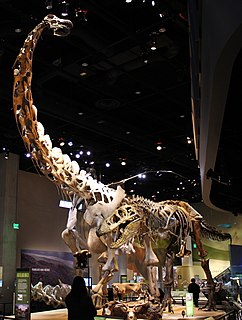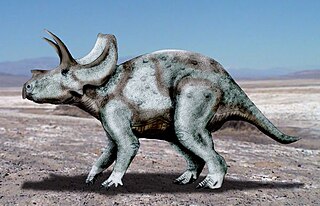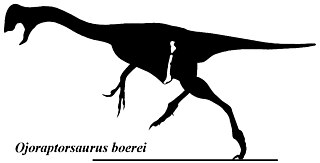 W
WThe Ojo Alamo Formation is a geologic formation in New Mexico spanning the Mesozoic/Cenozoic boundary.
 W
WAlamosaurus is a genus of potentially opisthocoelicaudiine titanosaurian sauropod dinosaurs, containing a single known species, Alamosaurus sanjuanensis, from the late Cretaceous Period of what is now southern North America. Isolated vertebrae and limb bones indicate that it reached sizes comparable to Argentinosaurus and Puertasaurus, which would make it the largest dinosaur known from North America. Its fossils have been recovered from a variety of rock formations spanning the Maastrichtian, though fossils of Alamosaurus that date back to the Campanian have been unearthed, age of the late Cretaceous period. Specimens of a juvenile Alamosaurus sanjuanensis have been recovered from only a few meters below the Cretaceous-Paleogene boundary in Texas, making it among the last surviving non-avian dinosaur species.
 W
WMyledaphus is a genus of Late Cretaceous cartilaginous fish whose fossils are known from Canada, the Midwest of the United States, Olmos Formation of the Difunta Group of Mexico, and the Beshtyubin and Bissekty Formations of Uzbekistan. It was a freshwater guitarfish that probably reached a length of 3 feet (91 cm), and had teeth adapted for a durophagous diet of animals such as clams. Most taxonomic authories place the genus in the Rhinobatidae, with a few placing it with prehistoric sharks (Anacoracidae), although the latter may be incorrect. Two species are known: Myledaphus bipartitus, the type species, and Myledaphus araucanus, named in 2019.
 W
WOjoceratops is a genus of ceratopsian dinosaur which lived in what is now New Mexico, United States. Ojoceratops fossils have been recovered from strata of the Ojo Alamo Formation, dating to the late Cretaceous period. The type species is Ojoceratops fowleri. It is very similar to its close relative Triceratops, though it is from an earlier time period and has a more squared-off frill. Nick Longrich, in 2011, noted that the squared-off frill is also found in some true Triceratops specimens and that Ojoceratops is probably a junior synonym of Triceratops, while Holtz (2010) noted that it is probably ancestral to Triceratops and possibly synonymous with the contemporary Eotriceratops.
 W
WOjoraptorsaurus is a genus of oviraptorosaurian dinosaur from the late Cretaceous. Ojoraptorsaurus is only known from pubic bones found at the Naashoibito Member of the Ojo Alamo Formation dating to the early Maastrichtian, about 69 million years ago. It was first named by Robert M. Sullivan, Steven E. Jasinski and Mark P.A. van Tomme in 2011 and the type species is Ojoraptorsaurus boerei. The generic name combines a reference to the formation with a Latin raptor, "plunderer", and a Latinised Greek saurus, "lizard". The specific name honours oceanographer Arjan Boeré who found the specimen.
 W
WQuetzalcoatlus is a pterosaur known from the Late Cretaceous of North America and one of the biggest known flying animals of all time. It is a member of the family Azhdarchidae, a family of advanced toothless pterosaurs with unusually long, stiffened necks. Its name comes from the Aztec feathered serpent god, Quetzalcoatl. The type and only species is Q. northropi.
 W
WRichardoestesia is a medium-sized genus of theropod dinosaur from the late Cretaceous Period of what is now North America. It currently contains two species, R. gilmorei and R. isosceles.